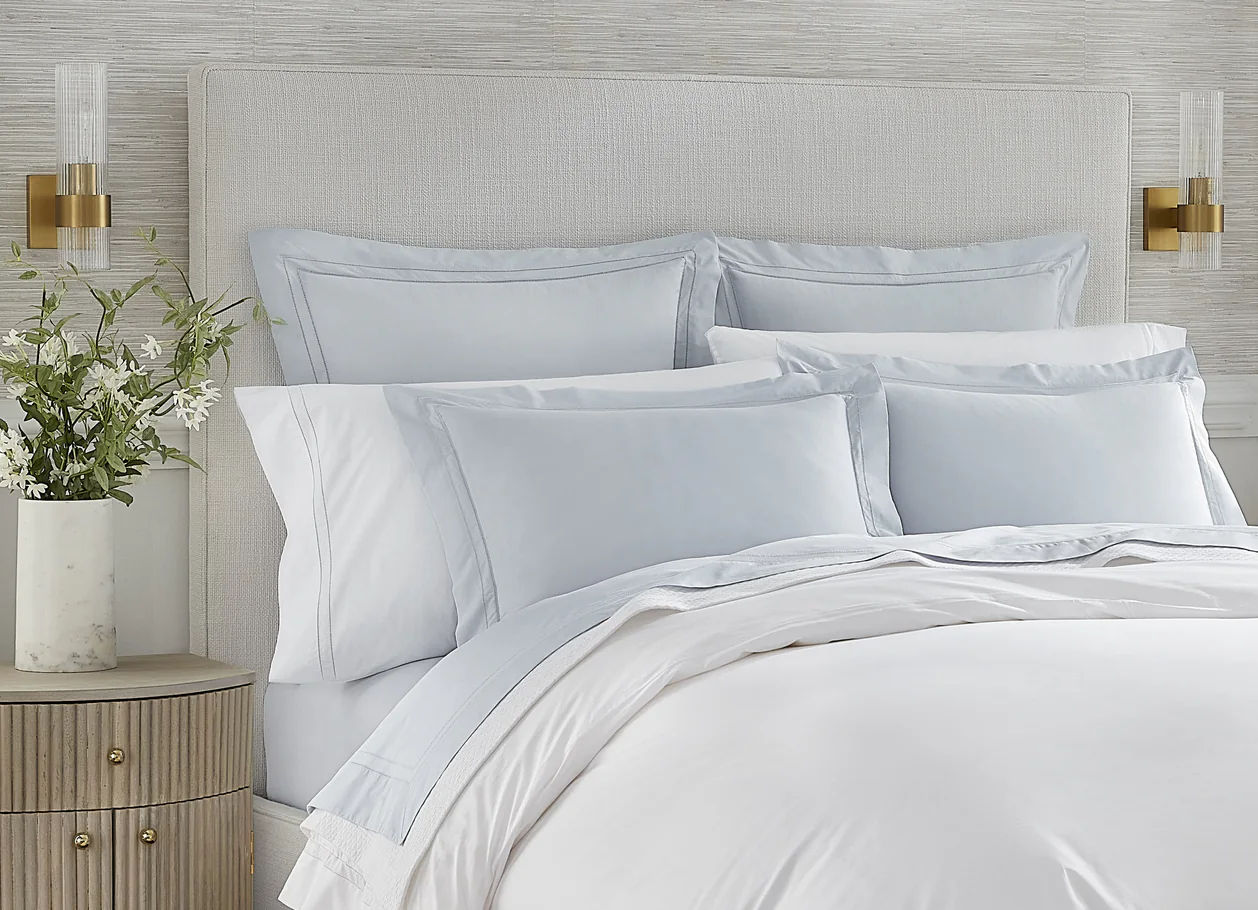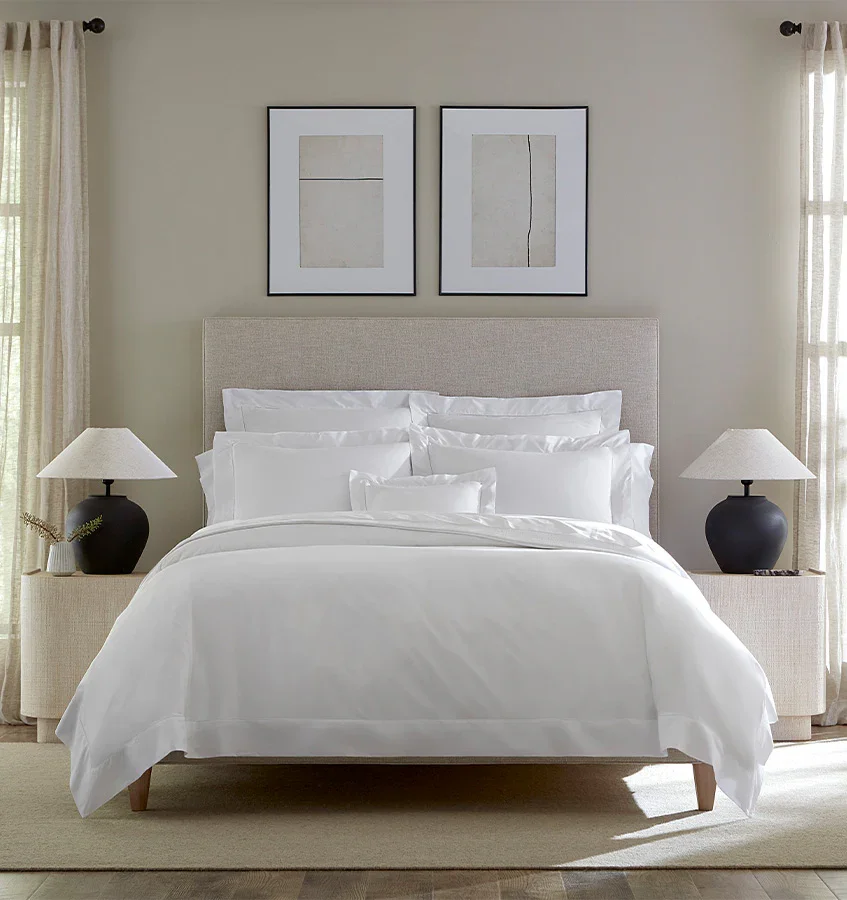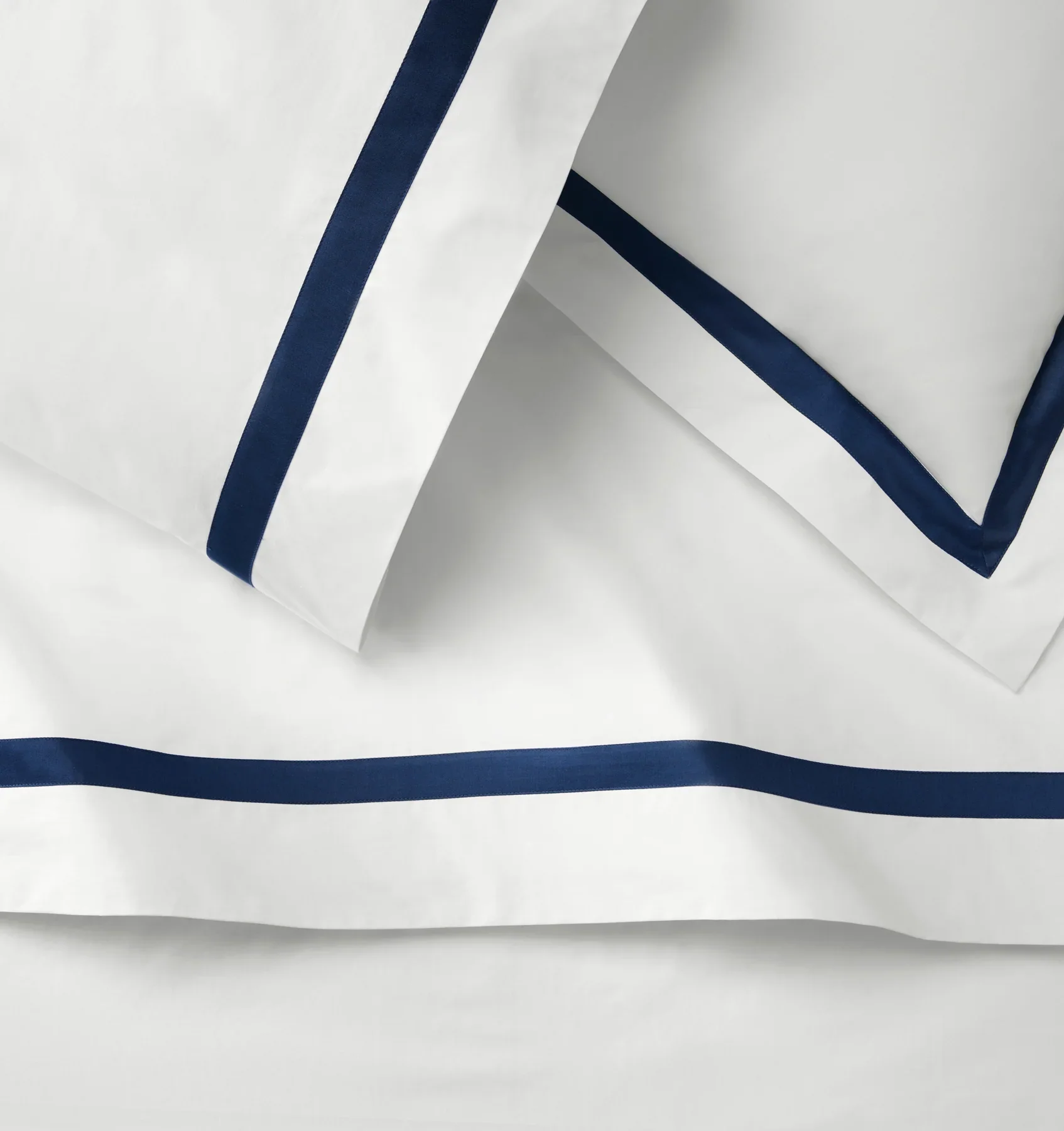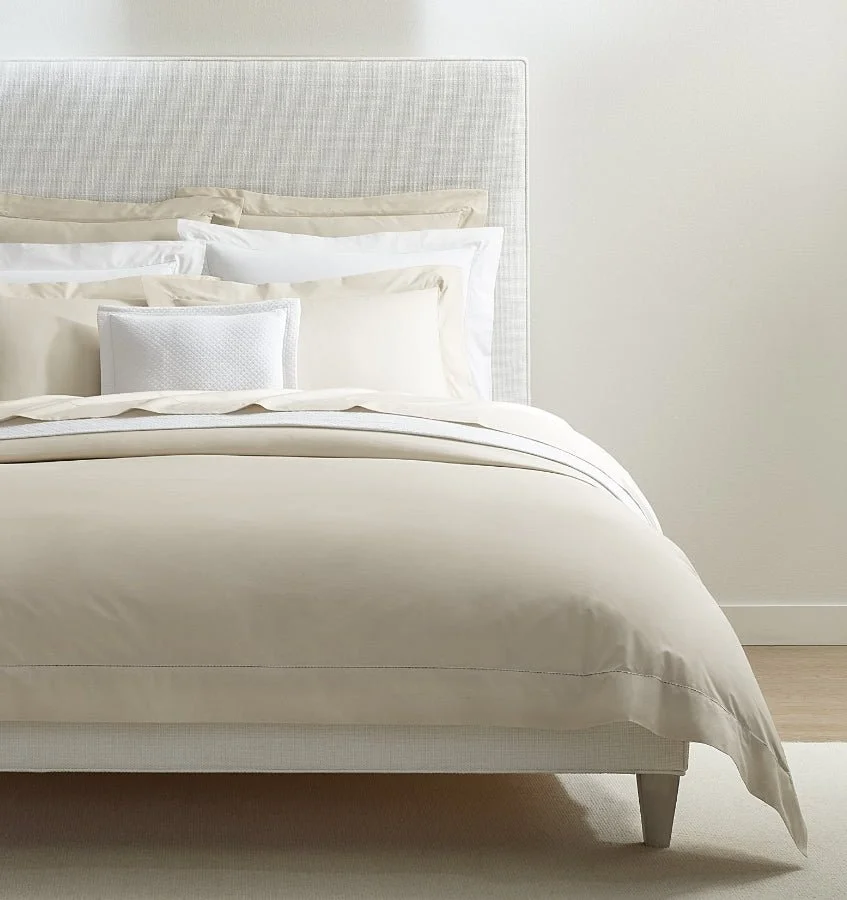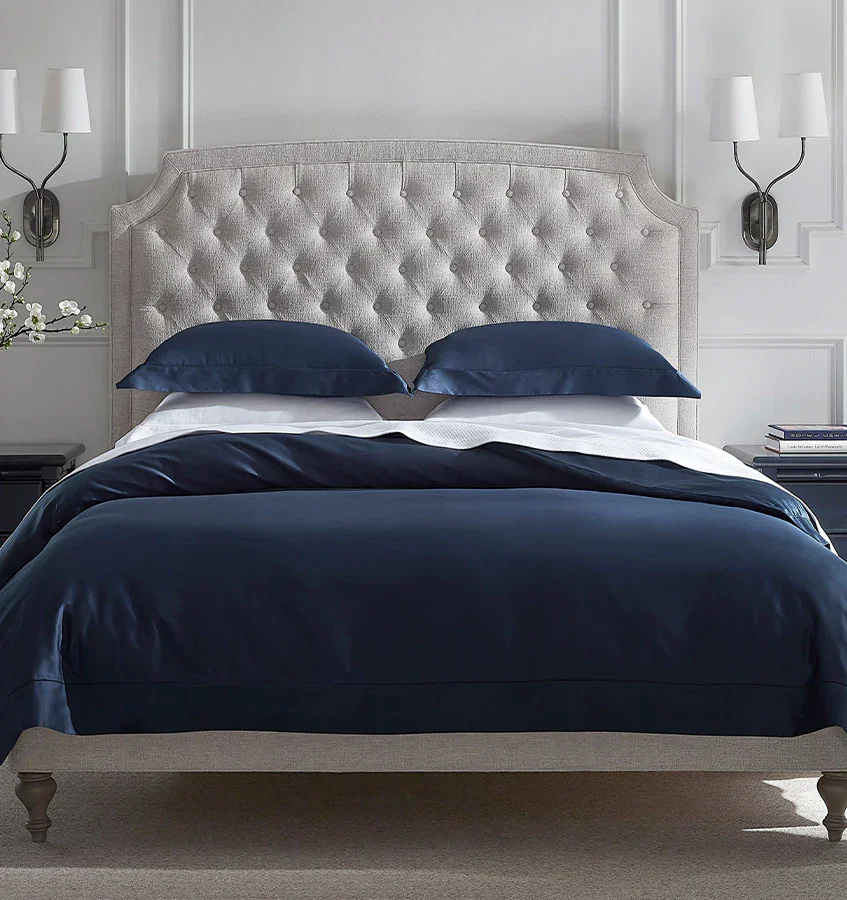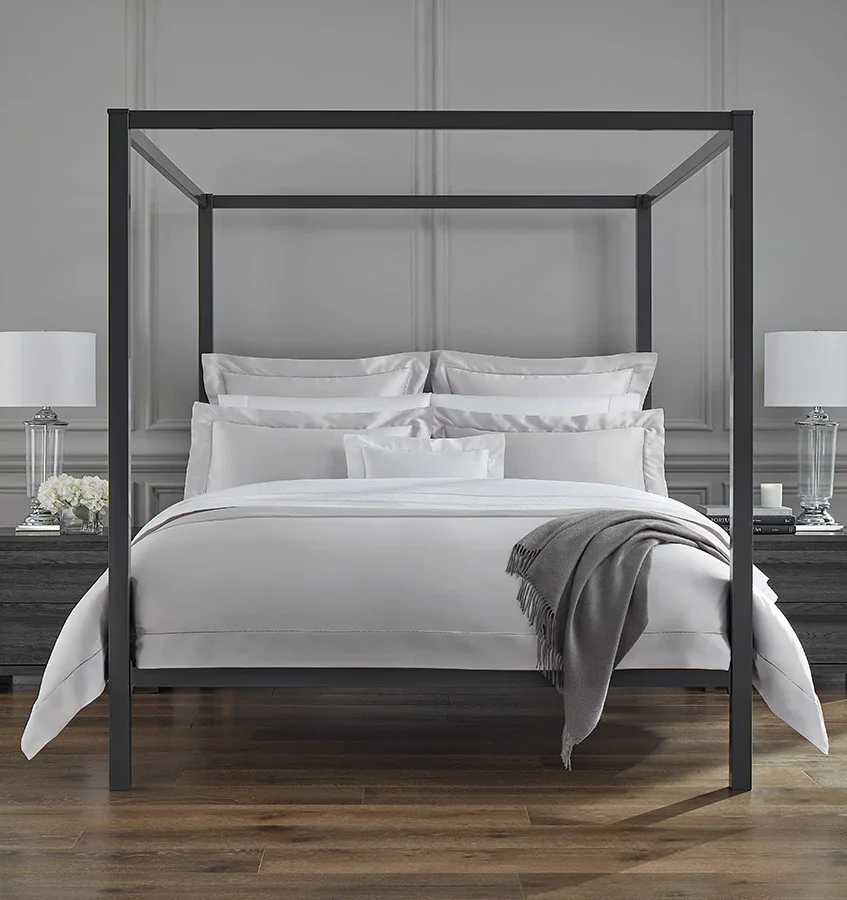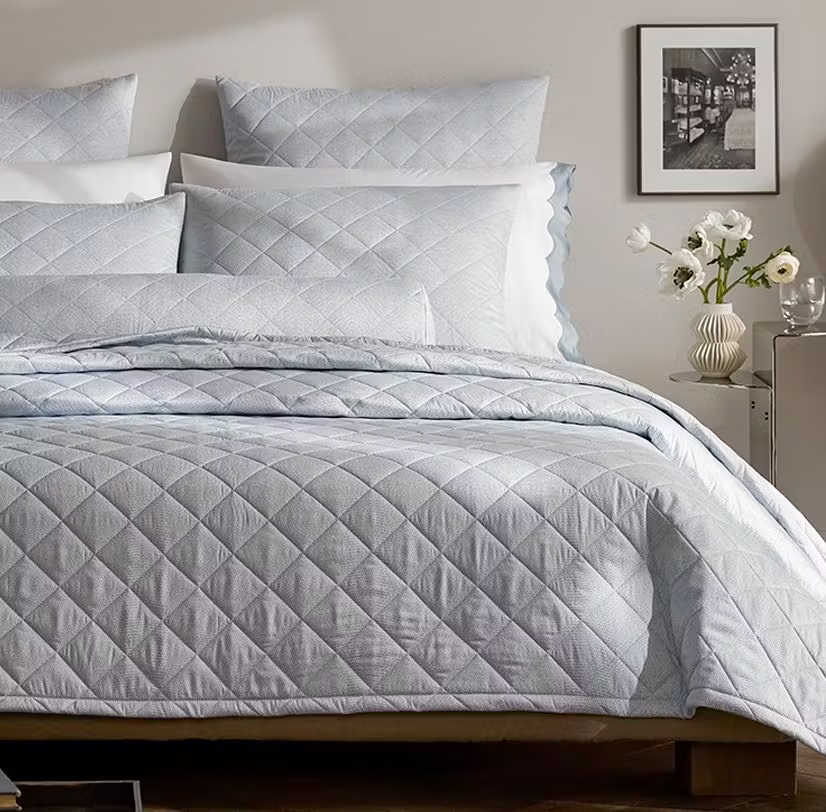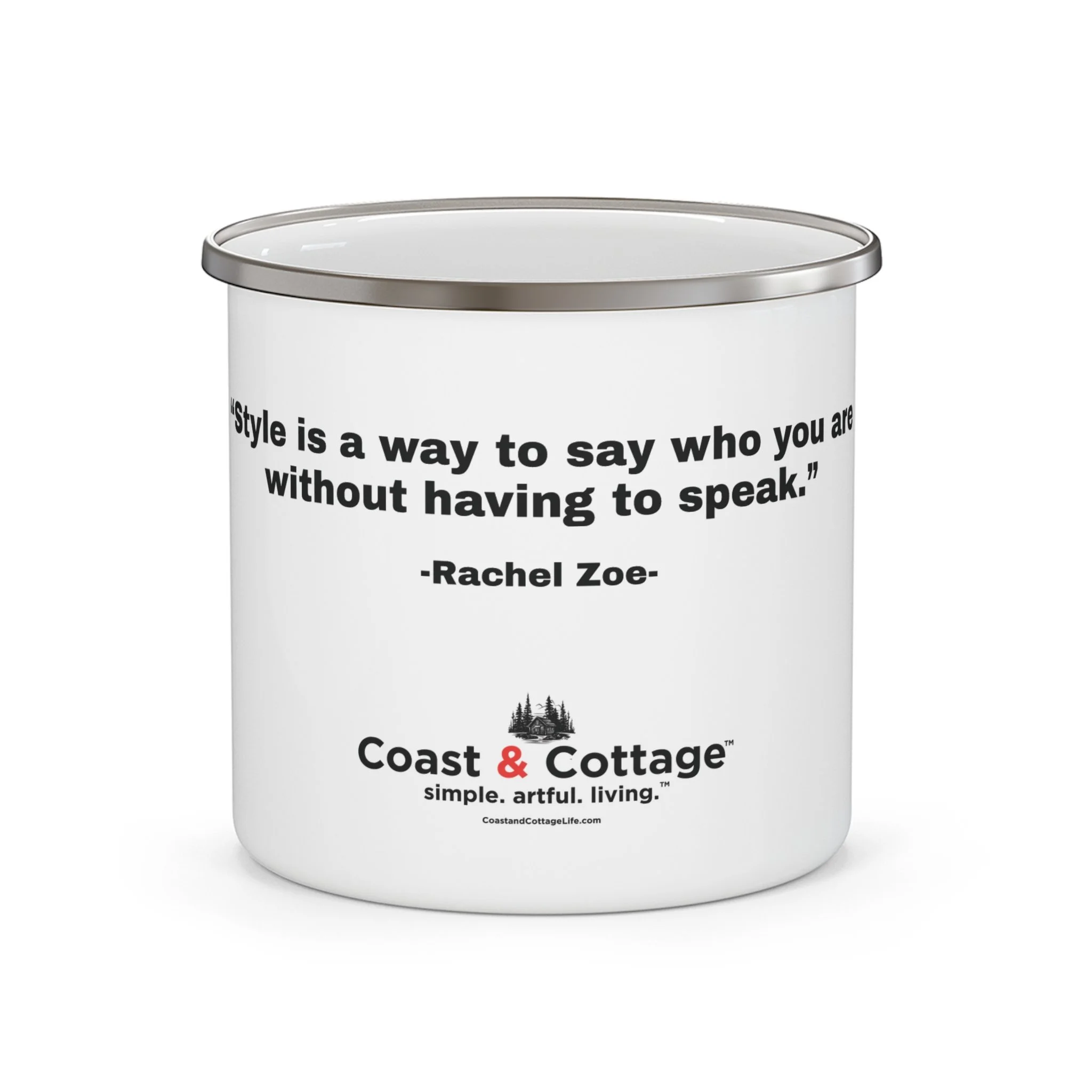Bed & Bath
"Don’t give up on your dreams—keep sleeping."
— Anonymous
Frette 1860 | Sferra | Matouk.
The true hallmarks of luxury bedding manufacturing lie in material selection and weave precision. Top-tier brands work with mills in Italy, Portugal, or France, known for their centuries-old textile traditions and highly controlled production processes. They start with the finest raw materials—such as Giza 45 cotton, Belgian or French linen, or silk sateen—and weave them using specialized looms that allow for greater tension control and finer detailing. Common weaves include percale, known for its crisp, matte finish, and sateen, which has a smoother, lustrous feel.
Fine Bedding
At the heart of fine bedding lies an uncompromising dedication to materials and weave integrity. The world’s most prestigious bedding brands source long-staple or extra-long-staple cotton, such as Giza Egyptian cotton or American-grown Supima, prized for its strength, softness, and ability to improve with time. Woven into percale, sateen, or jacquard fabrics in the textile mills of Italy, Portugal, or France, these fibers produce bedding that is not only beautiful to the touch but engineered to last.
Thread count plays a role—typically in the 300–600 range for premium cotton—but it’s just one element of quality. More important are the fineness of the yarns, the weave structure, and the finishing process, such as mercerizing or calendering, which enhance luster, durability, and softness. For linen bedding, the story is different: lower thread counts (80–150) are common and preferred, allowing the natural breathability and texture of the flax fibers—often sourced from Belgium or France—to shine through.
Luxury bedding is also defined by its construction: tailored seams, mitered corners, embroidery, piping, and custom finishes are hallmarks of craftsmanship. The result is a tactile, restorative sleep experience that elevates comfort into something closer to ritual.
Fine Bath Towels
The same principles apply in the bath. A truly fine towel begins with long-staple cotton—most notably Egyptian, Turkish, or Pima cotton—known for their absorbency, plushness, and strength. These fibers are spun into high-density yarns and woven into loops that create the towel’s pile. The GSM (grams per square meter) is a key quality indicator: fine towels typically range from 500 to 800 GSM, striking the balance between softness, absorbency, and drying time.
Luxury towels often go through additional steps such as pre-washing, combing, or zero-twist weaving, which enhances both the feel and longevity. They may be finished with double-stitched hems, decorative dobby borders, or jacquard accents, making them as beautiful as they are functional.
Whether in the bedroom or bath, fine textiles embody a certain philosophy: that comfort should be considered, not accidental; enduring, not disposable. These are products meant to be lived with, cared for, and appreciated—a daily luxury that never loses its quiet power.
Frette 1860
The History of Frette Bedding
Frette is one of the world’s oldest and most prestigious luxury linen brands, with a heritage dating back over 160 years. Known for its high-end bedding found in palaces, luxury hotels, and designer homes, Frette’s story is deeply rooted in Italian craftsmanship and European elegance.
Founding & Origins (1860s)
Founded in 1860 in Grenoble, France, by Edmond Frette, the company relocated shortly after to Monza, Italy—a move that marked the start of its deep ties to Italian textile artistry.
By 1865, Frette was manufacturing linens using the finest Egyptian cotton and had established a presence in Milan, aligning itself with the tastes of Europe’s elite.
Click Photo to Enlarge
Royal & Ecclesiastical Commissions
In 1881, Frette became the official purveyor to the Italian Royal Family—a significant milestone that cemented its reputation for excellence.
Frette was also commissioned to create linens for the Vatican, producing ecclesiastical textiles of extraordinary quality and symbolism.
Global Expansion & Hotel Partnerships
By the early 20th century, Frette linens were found aboard the Orient Express and in many grand European hotels.
Today, Frette is the choice of over 500 luxury hotels worldwide, including:
The Ritz Paris
Claridge’s London
The Peninsula Hong Kong
The St. Regis New York
Design Signature
Frette is synonymous with tailored elegance, fine embroidery, and timeless style.
Their hallmark styles include:
The Hotel Classic with double borders
Ornate jacquards and baroque-inspired motifs
Crisp percale and silky sateen made from long-staple Egyptian cotton
Modern Era & Legacy
In 2005, Frette was acquired by an Italian investment group, allowing for global brand expansion and modern retail.
Frette maintains flagship boutiques in Milan, New York, Paris, and Tokyo, alongside a thriving e-commerce presence.
Cultural Impact
Frette bedding has become a symbol of discreet luxury, frequently appearing in:
High-end residences and yachts
Editorial features in Architectural Digest, Elle Decor, and Vogue Living
Hollywood films and celebrity homes
"Sleeping in Frette"
To this day, “sleeping in Frette” is shorthand for experiencing one of life’s most refined comforts—a sensory indulgence woven into history.
-
Understanding Thread Count in Linen Bedding
When it comes to linen bedding, thread count doesn’t carry the same weight as it does with cotton, and in fact, it’s not the best indicator of quality. Traditionally, thread count refers to the number of threads per square inch of fabric, both vertically (warp) and horizontally (weft). In cotton sheets, a higher thread count—often in the range of 300 to 600—can suggest a smoother, denser weave, assuming the yarns used are of high quality.
Linen, however, is made from flax fibers, which are much thicker and longer than cotton fibers. Because of this, linen naturally has a much lower thread count, typically ranging from 80 to 150. This lower number isn’t a flaw—it’s part of what gives linen its signature breathability, texture, and long-lasting durability. Unlike cotton, high thread count doesn’t necessarily mean higher quality when it comes to linen.
Instead, you should look at other markers of quality. For example, the origin of the flax is important—many of the world’s best linens come from Belgium and France. The fabric weight, measured in grams per square meter (gsm), is another useful indicator. Lightweight linens fall around 120–150 gsm, mid-weight (ideal for bedding) ranges from 160–190 gsm, and heavier options are 200 gsm and above. Another factor is whether the fabric has been stonewashed, a process that softens the linen for a lived-in, relaxed feel. A tight, balanced weave and a smooth yet textural hand-feel also indicate quality craftsmanship.
So, what’s an ideal thread count for linen bedding? Generally, a good range is 80 to 120. Linen that has a thread count above 150 is likely made with finer yarns or a tighter weave, which may feel a bit smoother but might sacrifice some of linen’s natural breathability and airy texture.
Ultimately, people love linen bedding for more than just its tactile appeal. Linen is naturally temperature regulating, antimicrobial, hypoallergenic, and it actually gets softer with each wash. It offers a timeless, effortless style with rich texture and lived-in luxury that doesn’t rely on high thread counts to stand out.
Sferra
The History of Sferra Bedding
Sferra is one of the most respected names in luxury bedding, known for its impeccable craftsmanship, fine Italian textiles, and a legacy of understated elegance. Founded in the late 19th century, Sferra combines European heritage with American sensibility, catering to those who appreciate both tradition and innovation in fine linens.
Origins & Founding (1891)
Founded in 1891 by Gennaro Sferra, an Italian immigrant and master lace-maker who began selling handmade Venetian lace collars and cuffs to American high society.
Originally based in New York, Sferra’s early reputation grew among elite clientele for its Old World artistry and fine detail.
Click Photo to Enlarge
Early 20th Century: Expanding into Linens
As tastes shifted, Sferra evolved from lace into table linens and fine bedding, importing the finest textiles from Italy and establishing exclusive relationships with European mills.
The brand became synonymous with Italian-made quality and refined taste, earning a loyal following among upscale retailers and interior designers.
Post-War Growth & Craftsmanship Focus
Through the 20th century, Sferra continued to invest in cutting-edge textile technology while preserving its artisanal roots.
It introduced premium cotton percale and sateen collections with meticulous hand-finishing, hemstitching, and embroidery.
The Giza 45 Revolution (2001)
A milestone in bedding history, Sferra introduced Giza 45, often referred to as the “cashmere of cotton”.
Woven from Giza 45 Egyptian cotton, the rarest and most luxurious cotton in the world, the collection set a new global benchmark for luxury sheeting.
This innovation helped cement Sferra’s status as a true connoisseur’s brand in fine linens.
21st Century: Global Luxury Brand
Sferra is now a full-scale lifestyle brand offering:
Bedding and sheeting
Bath linens
Down products (pillows and duvets)
Decorative home accessories
Its production remains deeply tied to Italian craftsmanship, particularly in northern Italy, where family-owned mills continue to weave many of its signature fabrics.
Design Philosophy
Sferra combines classic aesthetics with modern performance—offering both timeless designs and luxurious basics with technical precision.
Its collections are known for:
Crisp percale
Lustrous sateen
Intricate jacquards
Hand-finished details
Today
Sferra is headquartered in New Jersey, with global distribution and a strong presence in top-tier retailers and interior design firms.
It remains a go-to name for designers and discerning homeowners who value authentic luxury and heritage-quality linens.
Matouk
The History of Matouk Bedding
Matouk is a storied American luxury linens brand known for its distinctive blend of Old World European craftsmanship and New England heritage. Since its founding in the early 20th century, Matouk has remained family-owned and deeply committed to producing exceptional-quality bedding, bath linens, and home textiles with a refined yet inviting aesthetic.
Founding & Early Years (1929)
Founded in 1929 by John Matouk, an immigrant from Damascus who trained in fine linen craftsmanship in Italy and France.
Matouk established his company in New York, bringing a European standard of artistry to the American market—especially during a time when hand-embroidered and finely woven linens were rare in the U.S.
Click Photo to Enlarge
Growth & WWII Challenges
During the Great Depression and World War II, Matouk maintained a reputation for uncompromising quality despite supply limitations.
The brand became a favorite among America’s upper class for European-style linens—lavishly embroidered, delicately tailored, and made from premium cotton and linen.
Post-War Expansion & Move to Massachusetts
In the decades after the war, Matouk expanded its offerings from table and handkerchief linens into luxury bed and bath collections.
In the 1980s, the company relocated to Fall River, Massachusetts, a region with deep roots in American textile manufacturing.
Modern Renaissance: Third-Generation Family Ownership
Now led by George Matouk, Jr., the founder’s grandson, the company underwent a transformation while remaining committed to its legacy of craftsmanship.
In 2005, Matouk opened a state-of-the-art solar-powered factory in Fall River, integrating:
Precision embroidery technology
Hand-cutting and sewing rooms
Sustainable production methods
This facility helped balance modern efficiency with traditional artistry—allowing the brand to offer custom monogramming, bespoke design, and embroidery options.
Design Signature
Matouk linens are beloved for their:
Tailored details (piping, applique, hemstitch)
Colorful trims and bold embroidery
Use of fine Italian-woven cottons
Collaborations with designers like Lulu DK and Schumacher have helped infuse the line with playful prints and coastal charm, while maintaining timeless appeal.
Sustainability & Craftsmanship
Matouk emphasizes environmental stewardship, sourcing responsibly and using energy-efficient manufacturing.
Their linens are often woven in Italy (especially from mills like Tessitura Monti or Tessitura Toscana Telerie) and finished in their Massachusetts facility.
Today
Matouk is considered one of the premier American luxury linen brands, blending European-quality fabric with a warm, welcoming New England sensibility.
Their products are sold in top home boutiques, luxury department stores, and through interior designers across the U.S. and abroad.










